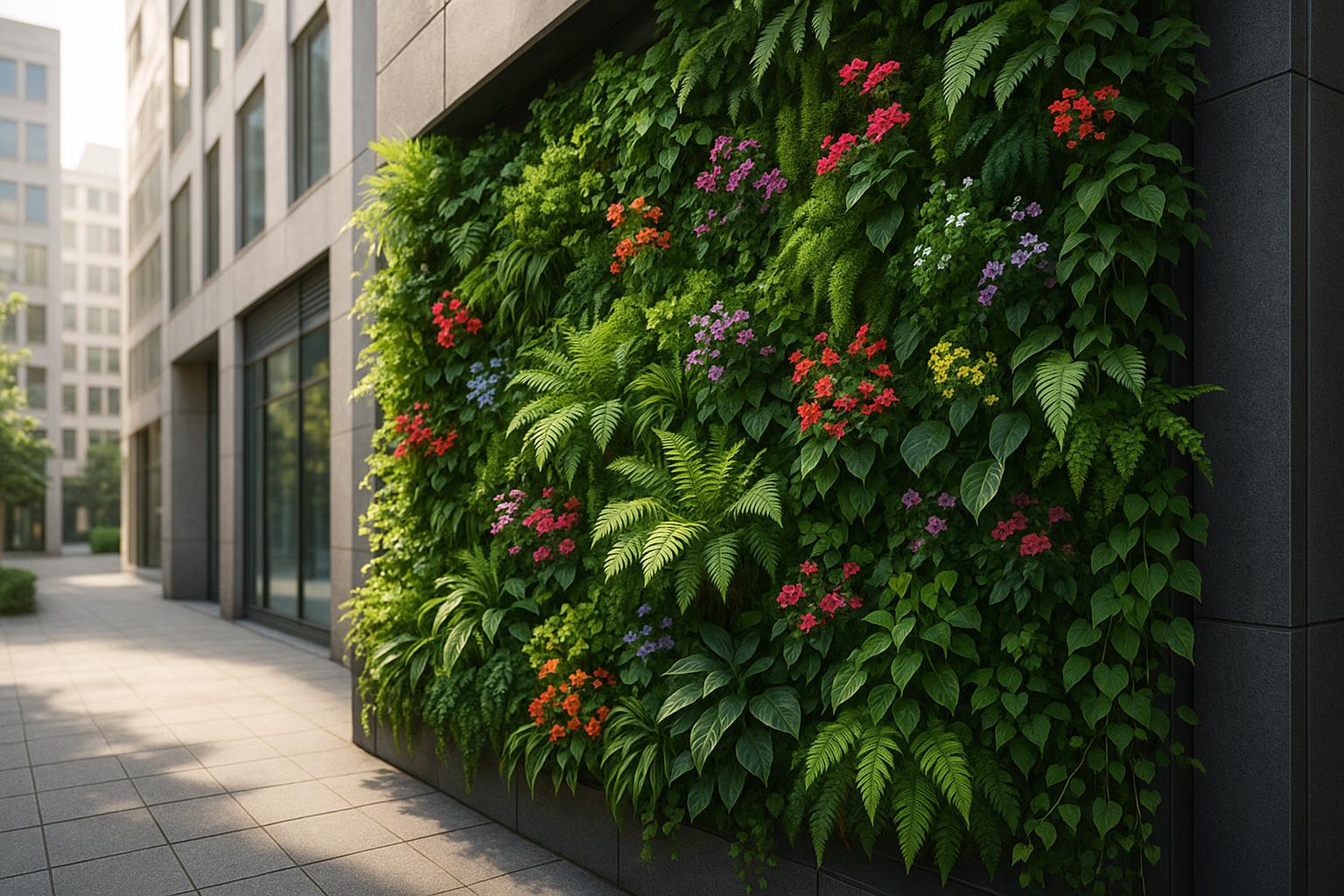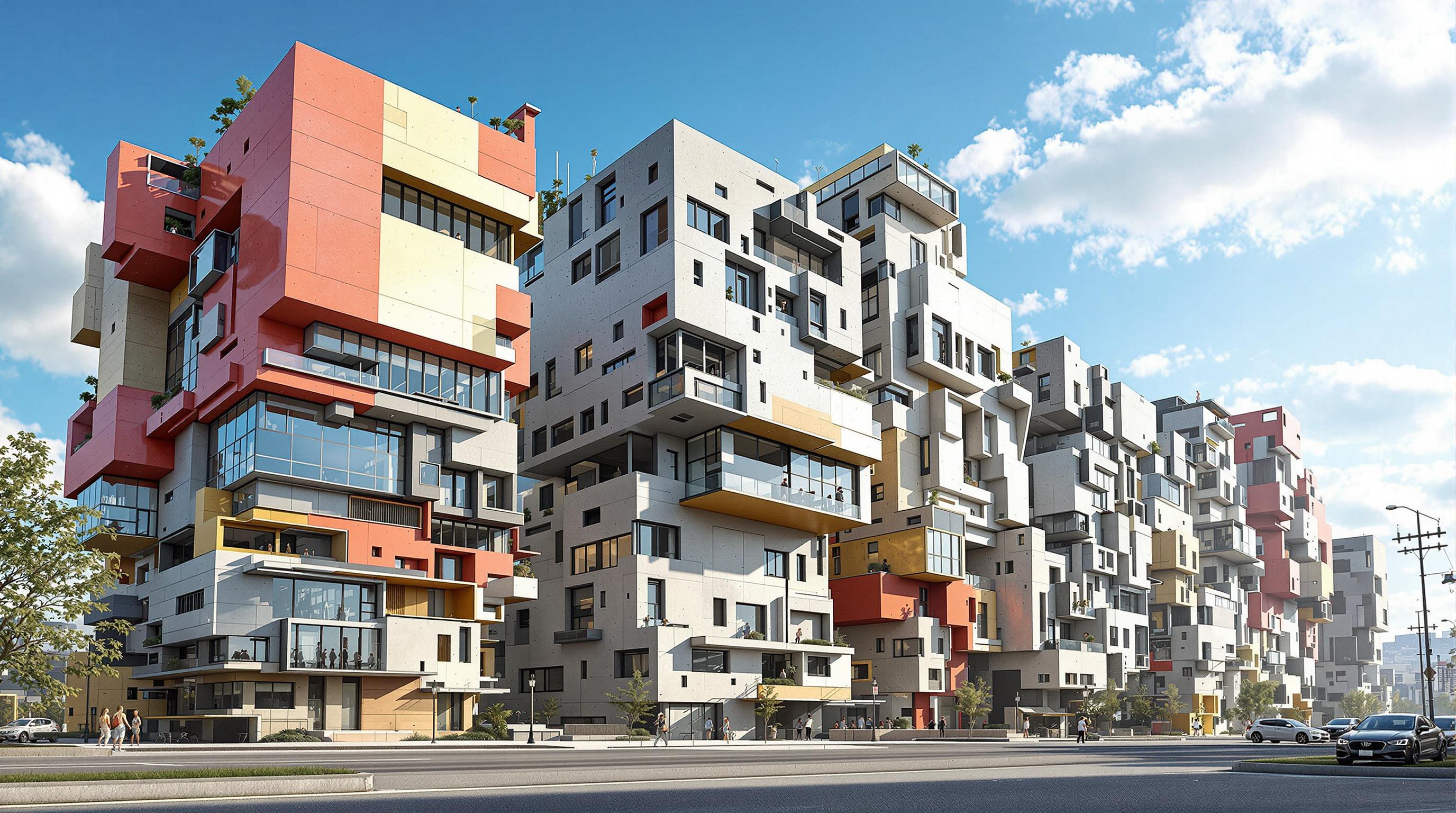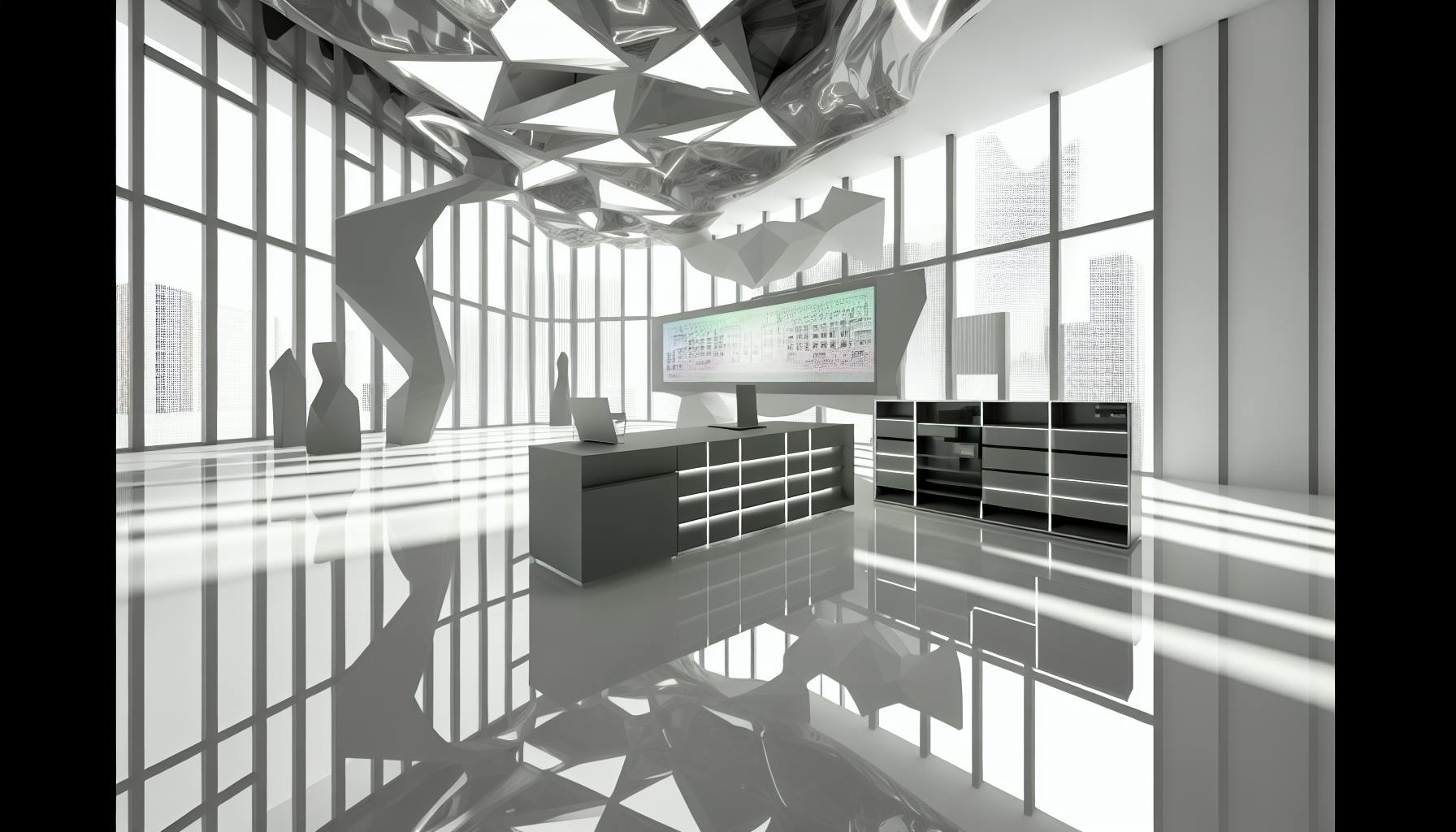Denver's skyline showcases a blend of historic landmarks and modern architecture. Here's a quick rundown of the city's most notable buildings:
-
Union Station: 1881 Beaux-Arts transit hub, now a dining and shopping center
-
Colorado State Capitol: Gold-domed government building with a "mile high" step
-
Daniels & Fisher Tower: 1910 clock tower, once the tallest structure west of the Mississippi
-
Denver Art Museum - Hamilton Building: Striking titanium-clad extension opened in 2006
-
Denver International Airport: Known for its tent-like roof mimicking mountain peaks
-
Wells Fargo Center: 52-story skyscraper nicknamed "The Cash Register Building"
-
Red Rocks Amphitheatre: Natural open-air venue carved into sandstone formations
-
Coors Field: Baseball stadium famous for high-altitude home runs
-
Millennium Bridge: Unique cable-stayed pedestrian bridge with a single mast
-
Kirkland Museum: Art museum housed in a vibrant yellow and gold building
These structures reflect Denver's growth from a Gold Rush town to a modern metropolis, blending historical preservation with innovative design.
| Building | Year Built | Key Feature |
|---|---|---|
| Union Station | 1881 | Renovated transit hub |
| Colorado State Capitol | 1901 | Gold dome |
| Daniels & Fisher Tower | 1910 | Clock tower |
| Denver Art Museum (Hamilton) | 2006 | Titanium exterior |
| Denver International Airport | 1995 | Tent-like roof |
| Wells Fargo Center | 1983 | Distinctive top |
| Red Rocks Amphitheatre | 1941 | Natural rock formation |
| Coors Field | 1995 | High-altitude baseball |
| Millennium Bridge | 2002 | Single-mast design |
| Kirkland Museum | 2018 | Yellow terra cotta exterior |
Related video from YouTube
1. Union Station

Denver Union Station isn't just an old building - it's a living piece of the city's history. Built in 1881 and rebuilt in 1914, this Beaux-Arts beauty has seen it all.
In 2014, Union Station got a $54 million facelift. It went from a dusty old train station to a buzzing hub where people eat, shop, and catch their rides.
What's inside? Picture this:
-
A huge Great Hall with sky-high ceilings
-
The Crawford Hotel (112 rooms, each one different)
-
Fancy restaurants and cool shops
-
Trains, buses, and more all in one spot
But they didn't stop there. In 2024, they dropped another $11 million to spruce things up even more. Ed Blair, who runs the place, put it simply:
"It was time to lift it."
They added comfy furniture, more plants, and gave the Great Hall a new look. Even the hotel rooms got an upgrade, showing off more of the building's original charm.
Now, Union Station sees over 30,000 people every day. It's not just a place to catch a train - it's where Denver comes to life.
Want to throw a party here? You can:
| Space | Cost |
|---|---|
| Half the space | From $10,000 |
| Entire center | From $20,000 |
Heads up: Prices change depending on when you book.
Union Station's story is Denver's story. It's gone from a simple train stop to the heart of the city, always changing but never forgetting its roots.
2. Colorado State Capitol
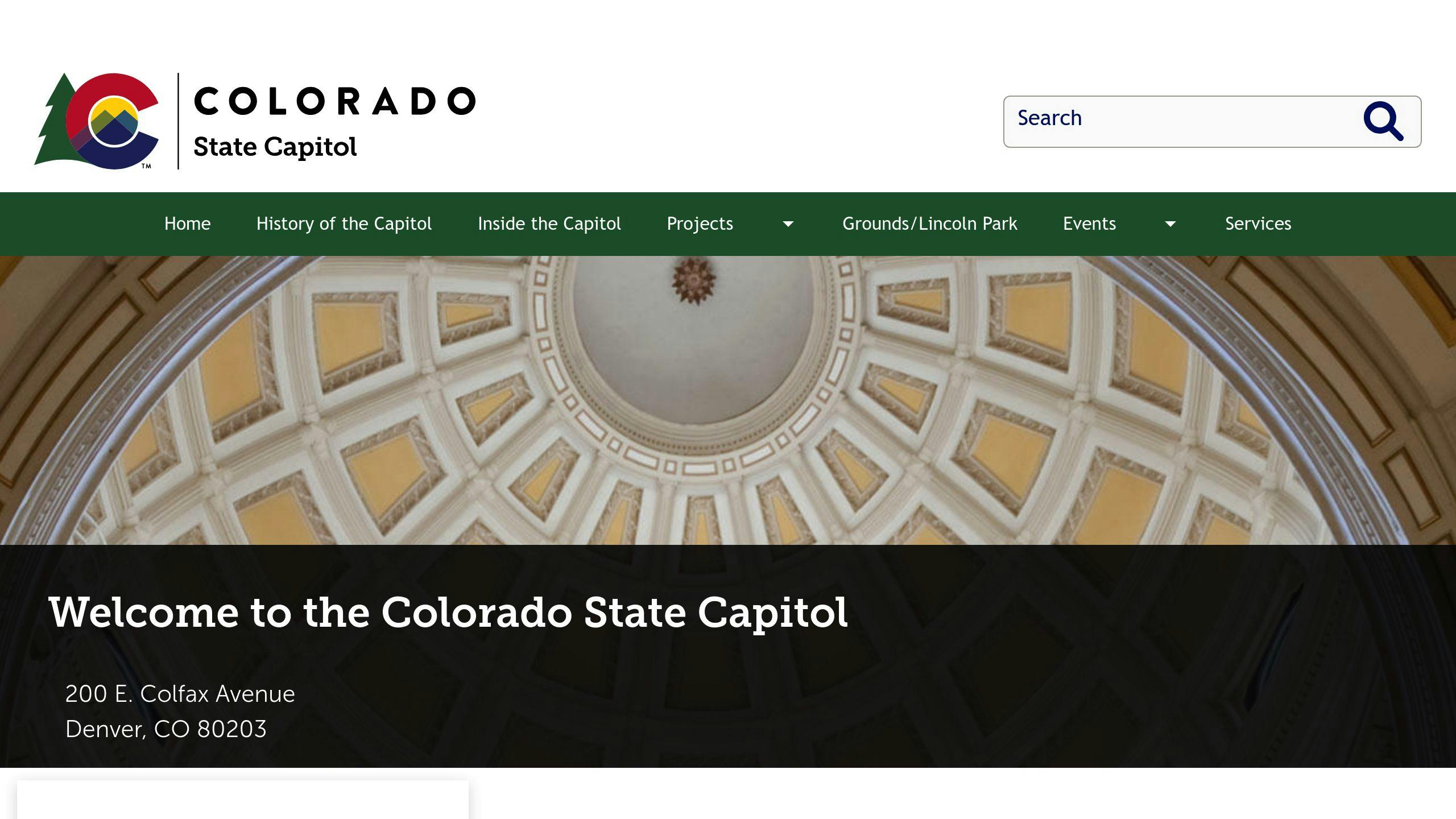
At 200 East Colfax Avenue in Denver, the Colorado State Capitol isn't just a government building. It's a slice of history you can walk through.
Built from 1886 to 1901, it's a mini-me of the U.S. Capitol in D.C. But with a twist: a gold dome that sparkles over Denver.
What makes it special?
-
It's decked out in Colorado white granite and rare Rose Onyx marble
-
The dome? Real 24-karat gold from local mines
-
Stand on the 15th step outside. Congrats, you're exactly a mile high!
Inside, you'll spot stained glass windows telling Colorado's story and presidential portraits lining the halls.
The dome's had its drama. In 2007, a chunk of iron took a tumble from inside. Cue a major facelift. In 2013, they gave the dome a fresh gold coat:
| 2013 Dome Makeover | |
|---|---|
| Gold Used | 65 ounces |
| Where From? | Teller County Mine, Cripple Creek |
| How? | Shipped to Italy, turned into leaf |
Want to see it yourself? Free tours run hourly from 10 AM to 2 PM. But get there early - it's first come, first served, and they cap it at 30 people.
"The Colorado state capitol building is one of the state's most recognizable landmarks." - Colorado Tourism Office
It's open from 7:30 AM to 5:00 PM. Pop in and soak up some Colorado history!
3. Daniels & Fisher Tower
The Daniels & Fisher Tower has been a Denver landmark since 1910. At 325 feet tall, it was once the highest structure between the Mississippi and California.
Architect Frederick Sterner took cues from Venice's St. Mark's Campanile, giving Denver an Italian Renaissance revival touch. The tower's mix of brick, stone, and terra cotta makes it stand out against the Colorado sky.
What makes the D&F Tower special?
-
A huge Seth Thomas clock with faces on all sides
-
A massive 2½ ton bell at the top
-
Balconies with great city views
The tower almost didn't make it. After the department store was torn down in 1971, preservationists stepped in. They saved it, and by 1981, it had a new purpose.
Here's what you'll find in the tower today:
| Floor | Use |
|---|---|
| Basement | Clocktower Cabaret |
| Floors 1-16 | Offices |
| Upper floors | Event space |
The tower's comeback shows how much Denver cares about its old buildings. It's so important that it made it onto the National Register of Historic Places in 1969.
Want to check it out? You can take a tour every Saturday. It's also a hot spot for weddings and parties.
At night, the lit-up clock faces still shine over Denver, just like they have for over 100 years. The Daniels & Fisher Tower isn't just a building - it's a piece of Denver's story, past and present.
4. Denver Art Museum - Hamilton Building

The Hamilton Building at Denver Art Museum is a showstopper. Opened in 2006, this 146,000 square foot extension is architect Daniel Libeskind's first completed U.S. building.
Libeskind took cues from the Rockies, creating a structure that echoes the mountain peaks. The exterior? 9,000 titanium panels that catch the Colorado sun, making the building shine.
Inside, you'll find:
| Collection | What's There |
|---|---|
| Modern and Contemporary Art | 16,000 sq ft, two floors |
| Oceanic Art | Pacific Island cultures |
| African Art | 1,000+ pieces |
The interior is just as bold as the outside. Angular walls and quirky spaces shake up the usual museum layout. At first, people wondered if it would work for showing art. Turns out, it does - and then some.
Libeskind put it this way:
"I was inspired by the light and the geology of the Rockies, but most of all by the wide-open faces of the people of Denver."
The Hamilton Building isn't just for art - it's a city connector. It links downtown, the Civic Center, and the golden triangle neighborhood.
Cool features include:
-
A gallery just for American artist Manuel Neri
-
Galleries organized by theme, not time
-
The Reiman Bridge to the Sie Welcome Center
This expansion lets the museum host big traveling shows and show off more of its own stuff. The building itself? It's a work of art that pulls in visitors from all over.
5. Denver International Airport
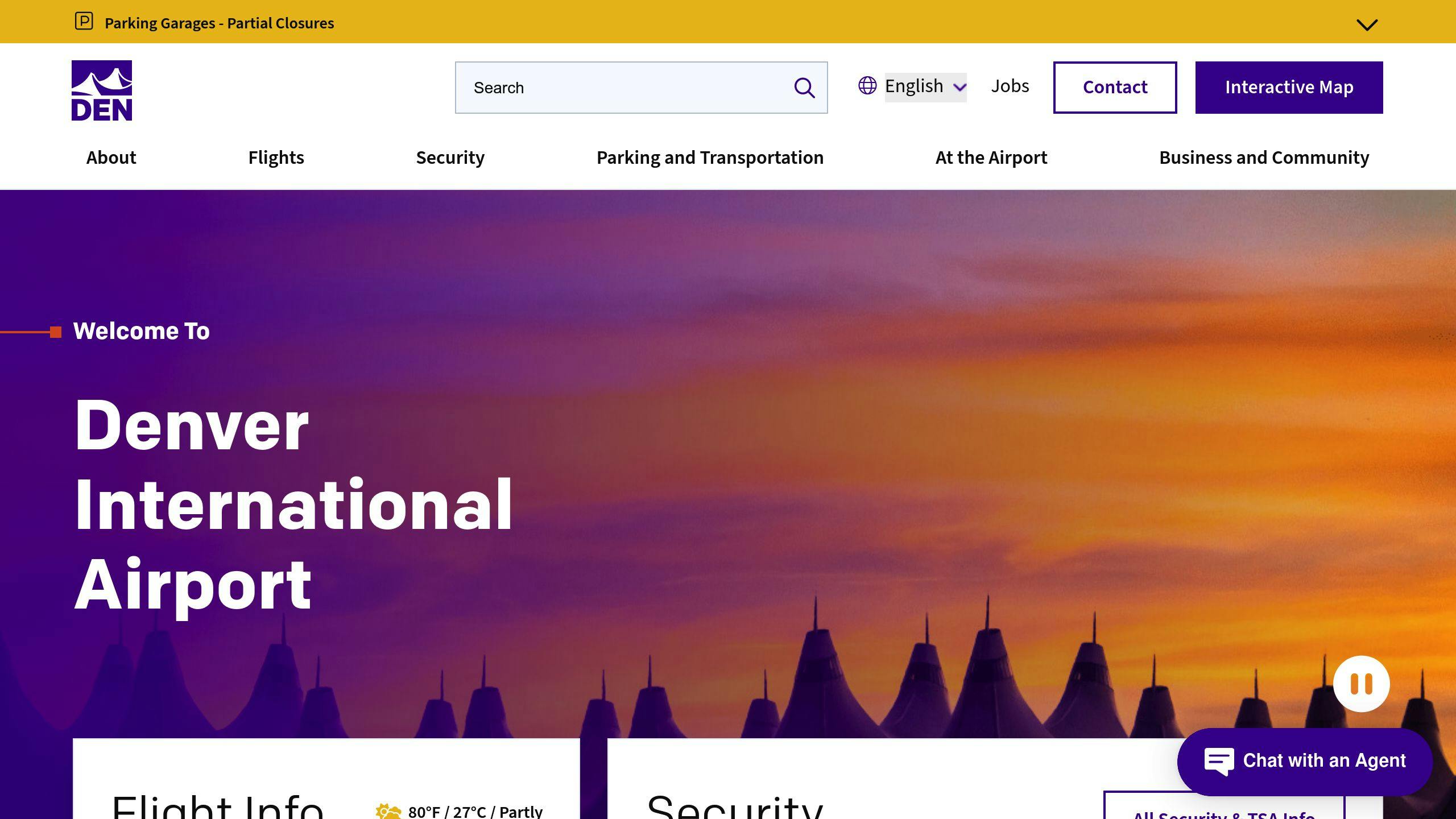
Denver International Airport (DIA) isn't your average airport. It's a standout piece of architecture and a major U.S. travel hub.
Opened in 1995, DIA's design broke the mold. The terminal's fabric roof mimics snow-capped mountains, spanning 2,000,000 square feet. Curtis Fentress, the lead architect, explained:
"We took all the mechanicals off the roof... This freed us to create a superlight cutting-edge structure, a canopy saturated with light."
This bold move paid off. The American Institute of Architects ranked the terminal #4 on its "Favorite American Architecture" list. Business travelers agree - they voted DIA "Best Airport in North America" for four straight years.
But DIA isn't just a pretty face. It's also a sustainability leader:
| Feature | Impact |
|---|---|
| Solar Farm | 3.5 million kilowatts of electricity |
| Natural Lighting | Less need for indoor lighting |
| Environmental Management | First airport in EPA's Environmental Track Program |
These design choices cut $115 million in construction costs and shaved nine months off build time.
DIA has a quirky side too. It's home to some odd art:
-
A 32-foot blue horse with glowing red eyes ("Blucifer")
-
Murals that sparked wild theories
-
A talking gargoyle that jokes about conspiracy theories
These oddities have made DIA famous beyond its role as an airport. It's even partnered with Roswell International Air Center, known for its alien lore.
From mountain-inspired design to weird art, DIA is more than a travel hub - it's a Denver landmark.
sbb-itb-1be9014
6. Wells Fargo Center
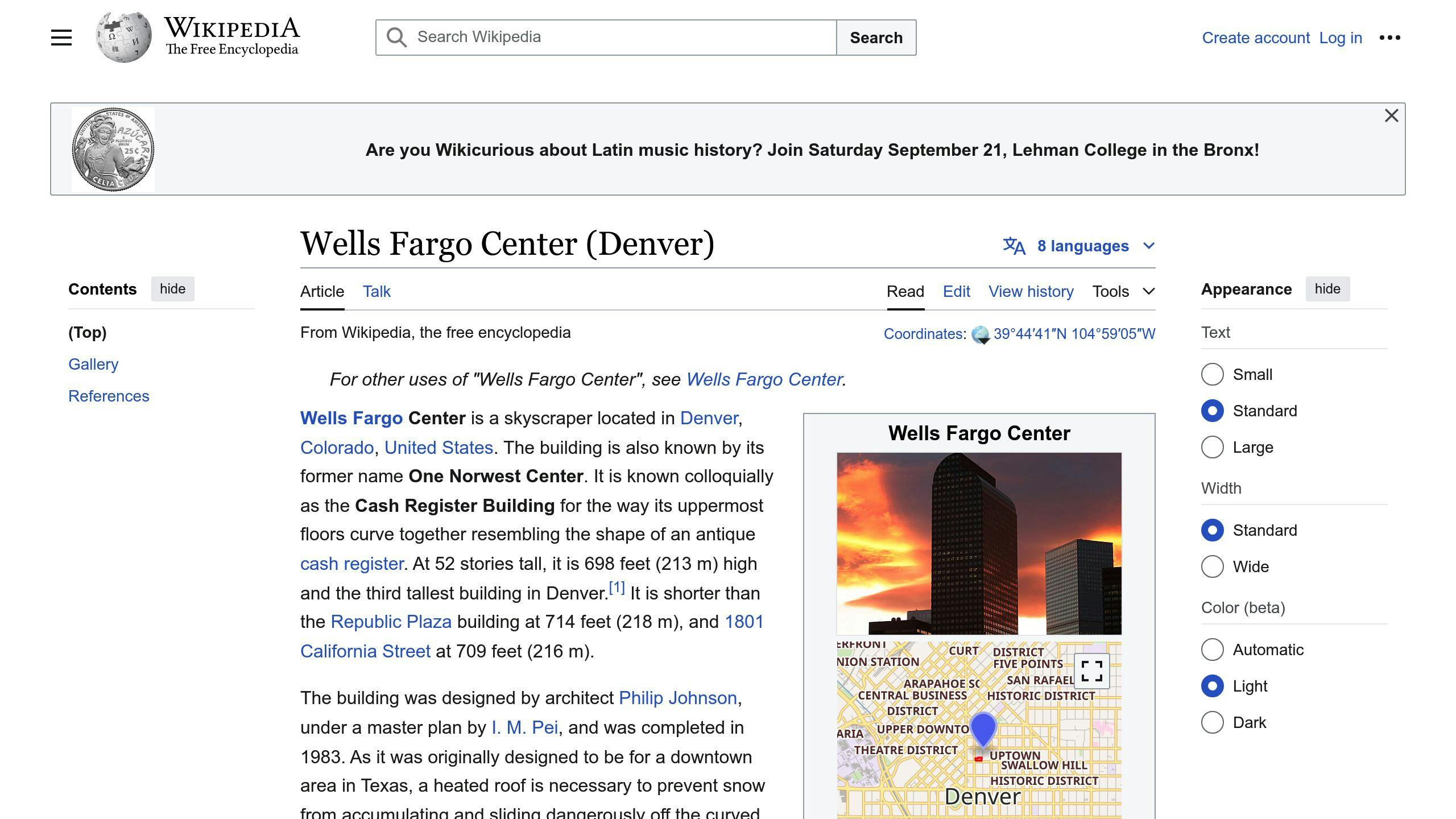
The Wells Fargo Center is a Denver icon. Built in 1983, this 52-story skyscraper stands 698 feet tall, making it the city's third-highest building.
Why's it famous? Its shape. The top looks like an old cash register, earning it the nickname "The Cash Register Building." Architect Philip Johnson's design made sure this building would stand out.
Here's what you need to know:
| Feature | Detail |
|---|---|
| Height | 698 feet (213 m) |
| Floors | 52 |
| Completed | 1983 |
| Floor Area | 1,190,400 sq ft (110,592 m²) |
| Architect | Philip Johnson |
It's not just for show. The Wells Fargo Center is a working office building with its own zip code (80274). A skybridge connects it to the Mile High Center next door, where you'll find food and a small museum.
In 2016, the building got a makeover. The lobby now sports an 8-story digital art display, blending old and new.
The outside? It's a mix of reddish granite and dark gray glass. At night, the glass and brass crown lights up, adding sparkle to Denver's skyline.
"We took all the mechanicals off the roof... This freed us to create a superlight cutting-edge structure, a canopy saturated with light", said Curtis Fentress, talking about a similar design at Denver International Airport.
This quote shows how Denver's architects think big.
The Wells Fargo Center proves office buildings can be more than just boxes. They can help define a city's character and skyline.
7. Red Rocks Amphitheatre
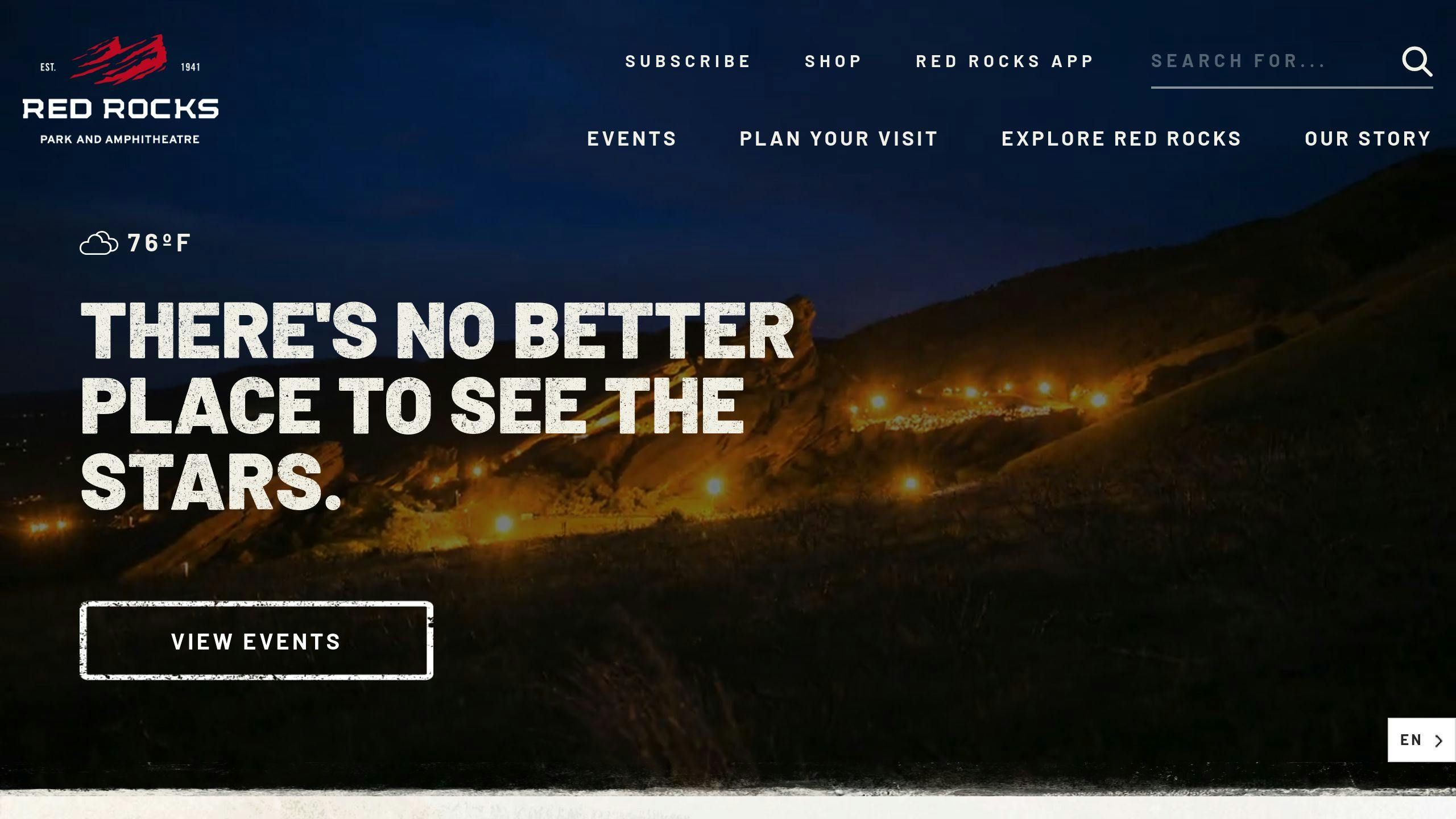
Red Rocks Amphitheatre isn't your average concert venue. It's a natural wonder that just happens to host incredible shows.
Picture this: You're sitting in an open-air amphitheater, surrounded by massive red sandstone formations. You're in Morrison, Colorado, just a quick 10-mile drive from Denver. And you're about to experience music like never before.
Here's what makes Red Rocks special:
| Feature | Detail |
|---|---|
| Seats | 9,525 |
| How high? | 6,450 feet |
| First show | June 15, 1941 |
| Brain behind it | Burnham F. Hoyt |
| Who owns it? | Denver |
The venue's design is pure genius. Two giant rocks, "Ship Rock" and "Creation Rock", flank the seats. A third rock forms the stage backdrop. It's not just pretty - it's why the sound is so darn good.
Red Rocks has seen some EPIC performances:
-
The Beatles rocked it in 1964, fresh off their Ed Sullivan Show debut.
-
U2's 1983 show? It made history. They even filmed it for a movie.
-
Jimi Hendrix played here once. Just once. But it was unforgettable.
"This place is 300 million years in the making. The sound is so good because the sandstone that makes up those monoliths absorbs it." - Brian Kitts, Denver Arts & Venues
Building Red Rocks was no small feat. They moved mountains (well, almost):
-
25,000 cubic yards of rock and dirt? Gone.
-
90,000 sq.ft. of flagstone? Laid.
-
10 carloads of cement? Poured.
-
800 tons of quarried stone? Placed.
-
30,000 pounds of steel? Reinforced.
In 2015, Red Rocks became a National Historic Landmark. It's not just a venue - it's a piece of American history.
But wait, there's more! Red Rocks isn't just about music. The park spans 738 acres. You can hike, do yoga, or catch a movie under the stars. It's a playground for locals and tourists alike.
So, next time you're near Denver, do yourself a favor. Check out Red Rocks. Your ears (and eyes) will thank you.
8. Coors Field
Coors Field isn't just the Colorado Rockies' home. It's a Denver icon that's changed the game since 1995.
High-Altitude Homers
At 5,200 feet above sea level, Coors Field is MLB's highest park. This isn't just trivia - it's game-changing:
-
Balls fly 9% farther than at sea level
-
303 homers hit in one season (1999 record)
-
Average 1999 game score: 8-7
The Rockies' solution? A humidor for the balls. It keeps them from getting too hard in Denver's dry air.
Old Meets New
| Feature | Detail |
|---|---|
| Facade | 1.4 million red bricks |
| Seats | 50,144 capacity |
| Views | Rocky Mountains visible |
| Unique Touch | Purple seats mark one mile high |
Beyond Baseball
Coors Field is more than nine innings:
-
The Rooftop: 38,000 sq. ft. of views and vibes
-
Dinger's Playground: Kid-friendly fun
-
The Sandlot: Fresh brews at Blue Moon Brewery
Denver's Game-Changer
The field boosted Denver's economy:
-
Sparked LoDo development
-
Local businesses thrived (Wynkoop Brewery saw 50% sales jump)
-
Transformed Denver's image
"Coors Field became the greatest marketing program anyone could ever imagine. Baseball was so new and exciting, and Denver was fighting against its image as a cow town." - John Hickenlooper, former Denver mayor
Did You Know?
-
45 miles of heated cables under the field
-
Center field fountains shoot 40 feet high after Rockies' wins
-
Almost named "Jurassic Park" after fossil discovery during construction
Coors Field is more than a ballpark. It's Denver's heart, bringing people together and offering a unique baseball experience. Fan or tourist, it's a Mile High must-see.
9. Millennium Bridge
Denver's Millennium Bridge is a game-changer. Built in 2002, this 130-foot pedestrian bridge links the 16th Street Mall to Commons Park, soaring over railway lines.
Why It's Special
The Millennium Bridge isn't your average walkway:
-
It's the world's first cable-stayed bridge using post-tensioned construction
-
A single 200-foot mast holds up the whole thing
-
It sits just 8 meters above street level (way lower than most)
Bridge Basics
| Feature | Measurement |
|---|---|
| Length | 130 feet |
| Width | 80 feet |
| Mast Height | 200 feet |
| Price Tag | $9 million |
Easy for Everyone
This bridge is all about accessibility:
-
Glass elevators at both ends
-
Minimal slope for easy walking
-
Improved stairs on the LoDo side (added in 2014)
Lighting It Up
In 2014, the bridge got a $1 million makeover:
-
New LED lights
-
80% more energy-efficient
-
Can change colors for events
"The new LED lighting will save the district money and improve energy efficiency by 80%." - Central Platte Valley Metropolitan District
City Connector
The Millennium Bridge does more than just span a gap:
-
Links downtown to western neighborhoods
-
Makes it easier to get to Union Station light rail
-
Adds a cool architectural touch to Denver's skyline
This bridge isn't just functional - it's a symbol of Denver's push for better city connections and modern design.
10. Kirkland Museum

The Kirkland Museum of Fine & Decorative Art is a gem in Denver's Golden Triangle Creative District. It's not your average art museum - it's a mix of art, history, and cool architecture all rolled into one.
The Building
Picture this: bright yellow terra cotta bars and golden glass panels. That's the Kirkland Museum's new home, opened in 2018. Jim Olson, the architect, calls it "the jewel box." And at 38,500 square feet, it's a pretty big jewel.
But here's the kicker - they didn't just build a new museum. They moved Vance Kirkland's original 1910 studio to the new site. It's the oldest commercial art building in Denver. Talk about bringing history along for the ride!
What's Inside
The Kirkland isn't just about one type of art. It's got three main collections:
-
Vance Kirkland's work
-
Colorado and regional art
-
International decorative art
How much art are we talking? Over 30,000 pieces total, with 5,000 to 6,000 on display at any time. And if you're into Colorado artists, they've got over 700 represented.
A Different Kind of Museum
Ever been to a museum where everything's neatly separated? Well, forget that. The Kirkland uses a "salon style":
-
Fine art and decorative art side by side
-
A chronological tour of Colorado art
-
Styles from realism to pure abstraction
It's like walking through time, from Art Deco to modern day.
"It's like time traveling when you walk through this door." - Maya Wright, Kirkland's education manager and historian
Just a heads up - it's for visitors 13 and up. Why? The collections are pretty fragile.
So, if you're in Denver and want to see a museum that breaks the mold, the Kirkland's your spot. It's where art, history, and architecture come together in one eye-catching package.
Conclusion
Denver's skyline is a mix of old and new. It shows how the city has grown from a small mining town to a big city.
Here's what makes Denver's buildings special:
-
Old buildings like the Daniels & Fisher Tower stand next to new skyscrapers
-
Some buildings can't be too tall because of rules about planes and mountain views
-
The city grows slowly but steadily
Denver keeps changing. They're fixing up old buildings and making new ones. For example, they're planning a new 30-story building at 1900 Lawrence.
The city is also working on some big problems:
-
They're spending $150 million to make the 16th Street Mall better for walking
-
They're turning empty buildings into homes for people who need them
These projects show that Denver wants to be a good place for everyone to live.
If you visit Denver, look at the buildings. From the Cash Register Building to the Denver Art Museum, each one tells a story about the city.
As Denver grows, it will keep trying to save old buildings while also making new ones. This way, people will always be proud of how the city looks.
FAQs
What is the most famous landmark in Denver?
Red Rocks Amphitheatre takes the crown as Denver's most famous landmark. This open-air venue, carved into natural rock formations, is a must-see for music fans and nature lovers.
But Denver's got more than just Red Rocks. Here are some other standout spots:
-
Denver Union Station: A historic transportation hub turned modern hangout
-
Colorado State Capitol: Look for the gold-plated dome (yep, real Colorado gold)
-
Denver Art Museum: Home to eye-catching art and architecture
-
Coors Field: Where baseball and mountain views collide
Each of these places tells a piece of Denver's story, from its mining roots to its current status as a vibrant city. Whether you're into history, art, sports, or just soaking up the local vibe, Denver's landmarks have you covered.
